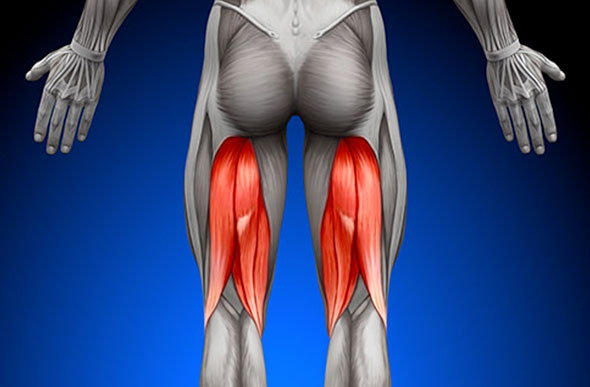Often solicited, but rarely stretched, the muscles Hamstring tend to stiffen. This shortening has the consequence of limiting the flexion movements of the leg, but also of the hip, which induces a compensation at the level of the vertebral column.lumbar spine which canson-in-law in the long run low back pain (lower back pain).
If you ask yourself the question, Stiff hamstrings: consequences and link with low back pain ? Discover some answers in this article.
Definition and anatomy
Anatomical reminder
The Hamstring (IJ) are a muscle group, located opposite the quadriceps. That is to say on the posterior face of the thigh.
They are formed by the union of these three muscles:
- The biceps femoris muscle
- The semitendinosus muscle
- The semimembranosus muscle.
They fit above on the ischial tuberosity (coxal bone) and below on the tibia (forming the classic crow's feet) and on the head of the fibula.
The motor innervation of Hamstring is ensured by the sciatic nerve (or ischial). This allows the functions of leg flexion and thigh extension.
Stiff hamstrings, why?
The Hamstring are mainly made up of muscle fibers that preferentially use the anaerobic pathway, that is, they do not require oxygen to produce the energy necessary for muscle contraction. In addition to this, they have the characteristics of having a rapid rate of contractibility, but a great fatigue.
The high proportion of connective tissue forming these muscles as well as the characteristics aroused, confer on this group a hypo extensibility often present at the origin of a stiffness.
Therefore, the hamstring stiffness will generally appear after an effort of too long duration or too intensive and will manifest itself by a reduction in the amplitude of the movements of flexion and extension of the legs.
Stiff hamstrings, how to determine?
The Hamstring are surely the muscles whosehypoextensibility is most often sought, therefore many tests will be carried out in order to highlight this muscle stiffness.
Classically, in the literature, two types of measures have been described:
Centimeter measurements
These include the following two tests:
- finger-to-ground distance (Schober's test ou finger to floor): evaluates the distance between the ground and the fingertip (middle finger), in maximum flexion of the trunk on the hips, knees in extension.
- Toe-to-toe distance : in the same way as the previous test, the subject performs a maximum flexion of the trunk, the legs stretched, in a seated position this time.
Angular measurements
-The angle of the popliteus (angle knee extension): the measurement of the popliteal angle makes it possible to highlight a retraction of the hamstrings. It is obtained, hip at 90 degrees.
-The hamstring extensibility test (straight leg raising): consists of raising the leg in extension, subject in dorsal decubitus.
Stiff hamstrings, consequences?
La stiffness muscular is often mild and transient. It usually has a moderate impact on daily life and resolves in most cases after a short rest.
However, it sometimes happens that this stiffness lasts over time or repeats itself regularly, which can have more significant consequences of varying severity.
- On a muscular level : the particular fibrous structure of the hamstrings increases the risk of muscle stiffness. This promotes and increases the risk of tear, elongation and breakdown.
- At the joint level : muscle (IJ) are muscles that allow the flexion movement of the knee. Thus, a decrease in the extensibility of these muscles will induce a knee stiffness, or even a sprain in rarer cases.
- At spine level, several studies have demonstrated a link between the decrease in the flexibility of these muscles and the appearance of low back pain (lower back pain). Hamstring stiffness is, in fact, considered today as a risk factor for the appearance of so-called non-specific low back pain.
Stiff hamstrings, what is the link with low back pain?
Given the many and varied functional roles of muscles Hamstring, many studies have focused on their extensibility properties. In particular on the demonstration of a direct link between a hamstring stiffness and lumbago.
Anatomical link
Prolonged inactivity (several weeks, months or even years) of the low back pain patient chronic results in a lameness disrupting the postures and activities of daily and professional life.
This lameness translates clinically into deconditioning syndrome which notably associates a loss of articular and musculotendinous flexibility and a specific deficit of the extensors of the trunk.
The Hamstring, muscles of the lower train, belong to this chain of extension. They thus act, both in terms of their extensibility and their strength, on the pelvis and, indirectly, on the Lumbar spine.
During an anterior flexion movement of the trunk, spinal mobility (mainly lumbar) and coxo-femoral mobility (anterior tilt of the iliac bone in relation to the femoral head) are brought into play.
For this anterior rocking to take place freely, the muscles bi-articular hamstrings must be sufficiently extensible alongside their role as an eccentric brake. Thus, these muscles come into play when straightening the trunk from a leaning forward position.
Consequences
The patients chronic low back pain often have great difficulty mobilizing their trunk and underuse the entire posterior chain of the lumbo-pelvi-femoral complex.
In subjects with stiff hamstrings, the pelvis is the victim of a constant traction towards the knees, inducing a retroversion of the pelvis at rest.
This retroversion causes a shift in lumbar vertebrae (L4-L5) and sacral vertebrae. This alters the natural lumbar lordosis, resulting in abnormal pressure on the front of the disc and stretching of the back of the disc causing the appearance of the pain.
Things to do
Keep in mind that a consultation with a health professional is imperative in case of muscle stiffness.
After questioning and a meticulous clinical examination, your doctor will assess the degree of your impairment.
He will be able to provide you with a medical treatment if necessary to calm your pain in case of association with a lumbago and refer you to a physiotherapist and / or a osteopath for an targeted hamstring therapy.
Flexibility exercises
These exercises aim to restore the natural extensibility of your Hamstring. Thus, the pelvis will no longer be maintained in posterior inclination and will again be able to assume its role of pivot in the movements. This will consequently allow the back to regain its natural lumbar lordosis.
Various exercises can be proposed, here are 02 examples:
- Alternate stretch : stand on one leg, the other straight resting on a chair, a stool…, hands on your hips, tilt your pelvis forward, straighten your back, head and shoulders and look straight.
- Un second exercise consists of remaining in a seated position, feet together with legs held and lean forward while keeping your back straight. Try to touch the balls of your feet.
Keep in mind that while the benefits of these stretches are obvious, they can be harmful if the exercise is done incorrectly.
Muscle strengthening
In the rare cases where the pain persists despite daily and adequate stretching exercises, a muscle building should be considered to provide support for the pelvis.
Indeed, building up your hamstrings isn't the first thing that comes to mind when it comes to lower back pain.
Personalized Hamstring well developed, allowbalance your muscles with that of the quadriceps which are often naturally more important.
Here are some examples of exercises that you can do at home (at bodyweight) or in a gym:
- Deadlift
- The squat
- Leg curl
- Front lunges
- Exercises with rubber band
Warning !
In order to avoid any injuries, it is imperative to work these muscles in flexibility. Many athletes are too stiff and strain or tear their thighs. It is therefore in your interest to take your stretching sessions seriously, whether static or dynamic.
References
https://www.lombalgie.fr/que-faire/exercices-assouplissement/
https://kinedoc.org/work/kinedoc/64d13bf5-ab58-45fc-96c1-eced0b25b2c0.pdf


